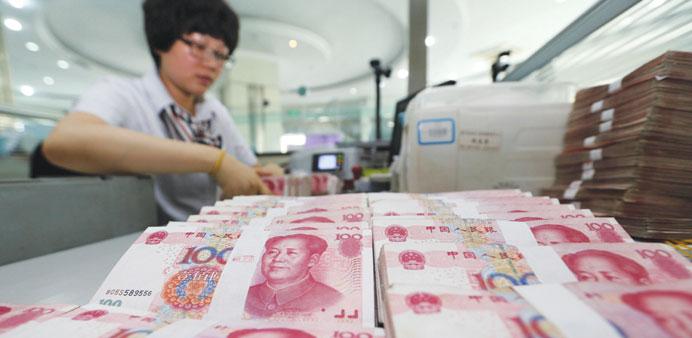A teller counts yuan banknotes in a bank in Lianyungang, east China’s Jiangsu province. China’s August 11 yuan devaluation and the strength of the dollar will weigh on the exchange rates in emerging markets, according Pimco’s Cyclical Outlook report.
Bloomberg
Hong Kong
Pacific Investment Management Co (Pimco) says nobody should be fooled by the best start to any month since April for emerging-market currencies.
The bond behemoth says China’s August 11 yuan devaluation and the strength of the dollar will weigh on the exchange rates, according to its Cyclical Outlook report.
“We expect Asian currencies to remain under pressure as they lose relative competitiveness with China due to the devaluation of the yuan,” Lupin Rahman, a London-based money manager at Pimco, which oversees $1.52tn of assets, wrote in the note released late on Thursday in Asia. “The risk-off sentiment due to China developments and the continued strength in the US dollar are likely to keep the pressure on most emerging-market currencies, which are acting as a release valve for their economies.”
A Bloomberg index tracking 20 developing-nation currencies has rallied 2.4% in October, while Colombia’s peso, Indonesia’s rupiah and Russia’s ruble have all gained more than 5% as the chances of a Federal Reserve rate increase this year receded. That came after the gauge plummeted 8.3% in the third quarter, the most in four years, as China weakened its exchange rate and commodity prices fell the most since 2008.
The headwinds are translating into slowing economic growth in developing nations, Michael Gomez, Newport, California-based head of emerging-markets portfolio management at Pimco, wrote in the same note. The asset manager said it’s still “cyclically cautious” on these countries, although it has reserved “dry powder” so it can add exposure when it sees opportunities.
“The recent bout of shocks highlights the cyclical risks that many EM countries are still vulnerable to,” said Gomez. These include “commodity cycles, political turmoil and periods of market volatility and risk aversion,” he said. The economies of Brazil, Russia, India and Mexico will expand around 2-3% on average over the next 12 months, Pimco forecast.
There are “important downside risks” as China decelerates and emerging markets struggle to come up with growth models outside of exports and commodities. Although a Bloomberg index of raw material prices has rallied 2.2% in October, it is down 14% for 2015.
China’s surprise devaluation sent the yuan into its biggest decline in two decades and prompted a reassessment of the extent to which Asia’s largest economy is slowing. China plays an increasingly important role in the macro outlook for most developing nations, not just in Asia, said Rahman.



